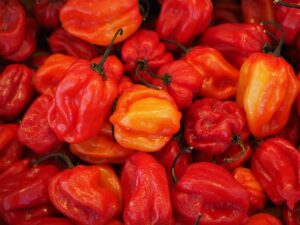When it comes to home gardening, few experiences can match the thrill of growing Habanero peppers. Known for their tantalizing heat and rich flavor, Habaneros are a staple in the kitchen of any spice connoisseur and have a storied history dating back centuries. Whether you’re a dedicated garden enthusiast, a budding green thumb, or simply adore the sensations of spicy cuisine, learning to grow Habaneros will not only provide an attractive addition to your garden but will also yield a versatile ingredient that can be used in numerous culinary adventures.
This guide is your gateway to the vibrant world of Habaneros peppers; from planting the first seedling to the harvest of those fiery pods, we’ll cover everything you need to know to grow Habaneros successfully at home. We’ll explore the origins and culinary uses of this pepper, essential tips for the initial stages of growth, how to nurture your Habanero plant, and even provide you with delicious recipes to savor the fruits of your labor.
Introduction to the Habanero Pepper
Origins and History
Originating from the Amazon and then spreading to the Yucatan Peninsula, the Habanero pepper—named after the Cuban city of La Habana—has a fascinating history steeped in South American and Caribbean cultures. It’s been a key ingredient in the complex flavor profiles of dishes like Mexican salsas and Jamaican jerk marinades for generations. Interestingly, it’s also a notable ingredient in hot sauces that claim world records for their spiciness.
Flavor Profile and Culinary Uses
Habaneros are beloved for their distinctively fruity, almost floral flavor, which sits alongside their searing heat on the Scoville scale. Their taste varies slightly depending on the ripeness of the pepper, with a more mature Habanero yielding a sweeter heat than the still-green variety. This complexity makes them ideal for adding layers of flavor to dishes, prevailing in sweet and spicy recipes such as mango habanero salsas, spicy margaritas, and chocolate desserts.
Getting Started
Essential Tips for Growing Habanero Peppers at Home
Growing Habanero peppers at home begins with thoughtful preparation. Here are some vital tips to kick off your growing adventure:
- Seed Selection: Pick high-quality seeds from reputable suppliers or save the seeds of a particularly tasty pepper you’ve enjoyed.
- Location: Find a spot in your garden that gets at least six hours of sunlight each day. Habanero plants love warmth and plenty of light.
- Spacing: Give each plant plenty of room to grow, which means about 18 inches apart from other plants.
- Soil: Ensure that the soil in your chosen location is well-draining. Habaneros require regular watering, but they don’t like soggy roots.
- Fertilizer: Choose a balanced fertilizer with equal parts nitrogen, phosphorus, and potassium to
- Container Gardening: If space is limited, consider growing Habaneros in containers. Just ensure they have good drainage.
- Companion Plants: Certain plants, like basil and tomatoes, can make great neighbors for Habaneros, improving growth and flavor.
Understanding the Habanero Plant
Growth Stages and Specific Needs
The growth cycle of Habanero plants is crucial to understand and support. Here’s what you can expect:
- Germination: This is where it all begins; warm, damp soil is essential to this stage. Consider using a seedling heat mat to help things along.
- Vegetative Growth: Once your seedlings sprout, they’ll require good airflow, regular watering, and an occasional light feeding.
- Blossoming and Fruiting Phase: As your plant matures, watch for blossoms, and be patient—peppers can take several weeks to develop fully.
- Maturity and Harvest: You’ll know your peppers are ready to pick when they reach their full color and are firm to the touch.
Overcoming Common Challenges
Preparing for Pests, Diseases, and Climate Variability
Insects and diseases can pose a significant threat to your Habanero crop. Here’s how to deal with them:
- Pests: Keep a watchful eye for slugs, aphids, and spider mites. Many organic solutions and deterrents can help keep them at bay.
- Diseases: Fungal infections, such as powdery mildew, can affect your peppers. Maintain good air circulation and consider preventive treatments.
- Climate: Habaneros thrive in warm, humid conditions, but they’re sensitive to both excessive heat and cold snaps. Use mulch to regulate soil temperatures and be prepared to protect plants during unexpected temperature changes.
Harvesting and Preserving Habaneros
Best Practices for Optimal Flavor
Knowing when to harvest your Habaneros is key. And when you do, here’s how to make their flavor last all year:
- Timing: Harvest when the pepper is fully ripe and its color has developed a deep shade, whether that’s orange, red, or even chocolate brown for some varieties.
- Preservation: There are several techniques, including drying, pickling, or freezing, that can help you keep the flavor and spice of Habaneros well beyond their growing season.
Recipes and Culinary Inspiration
Creative Ways to Use Fresh and Preserved Habaneros
Once you’ve got your harvest in hand, the culinary wealth of Habaneros is yours to explore. Here are some delicious pepper-powered recipes to try:
- Mango Habanero Salsa: A classic that balances the intense heat of the pepper with the sweetness of mango.
- Habanero Hot Sauce: Make your blend from scratch for the ultimate customization.
- Spicy Chocolate Truffles: Satisfy both your sweet tooth and your love for heat with these decadent, unexpected treats.
Conclusion
Gardening Habanero peppers is an adventure full of spice and flavor. While it can be challenging at times, the rewards—both in the garden and in the kitchen—are well worth the effort. Remember to document your experience, try new things, and share the joy (and heat) of growing your own Habaneros with others.
For further inspiration and resources, consider joining online gardening communities, subscribing to horticultural magazines, or attending local gardening workshops. Happy growing, and here’s to many successful and spicy harvests in your future!

